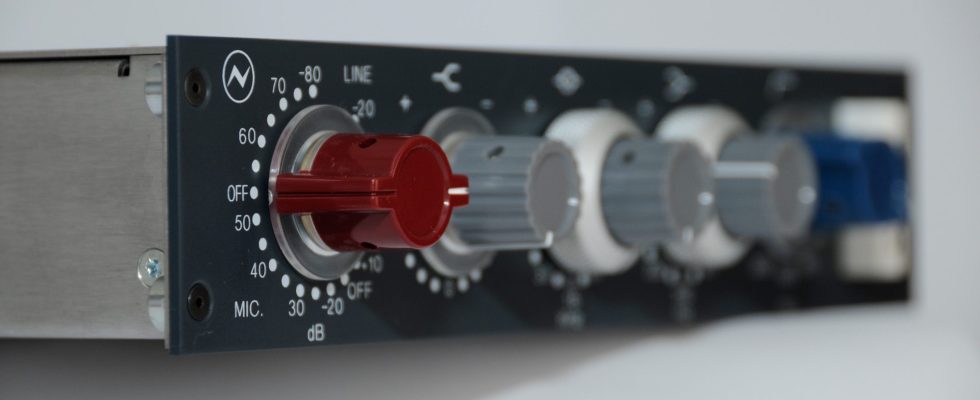The original – the legend – the role model
May 1, 2023
AMS Neve 1073N, 1-channel microphone preamp
Holding the AMS Neve 1073N in your hand actually feels quite normal. Well, it’s not glowing in any way and there isn’t a bright shimmer coming from it either. In fact, he’s quite sober. A Pultec EQ or an original Universal Audio Teletronix LA-2A makes a lot more of a difference with the switches and controls that seem to come from an old railroad switching mechanism. But still, this is the (mostly) original of all 1073 mic amps. No Heritage Audio, Warm Audio, Black Lion or Golden Age. It’s THE 1073. OK, now I’ve got goosebumps…
AMS Neve or just Neve – or Rupert Neve Designs?
I’ll make it easy for myself this time, because I already described this in the test of the AMS Neve 88M:
(…) Before the test, we have to clarify how the topic “Neve” behaves, because there are two companies: AMS Neve (AMS = Advanced Music Systems) and Rupert Neve Designs. In fact, prior to collaborating with AMS, Rupert worked with and even owned a number of companies (CQ Audio, Rupert Neve Company, etc.). Through the merger in 1990, AMS Neve is the manufacturer of the classic Neve devices as used in the legendary studios. AMS Neve is now based in Burnley UK.
In 1985 Rupert Neve founded Focusrite Ltd with his wife Evelyn. was founded, which later became the well-known Focusrite Audio Engineering company. However, Rupert Neve never designed devices for the “new” Focusrite.

In 1994 Rupert and his wife moved to Texas and became US citizens (2002). The company Rupert Neve Designs was founded there in 2005, which to this day produces modern studio equipment according to the master’s specifications. Unfortunately, Rupert Neve passed away in 2021. (…)
In terms of authenticity, AMS Neve is therefore very close to the original Neve devices and, apart from a few details, is even identical in construction. The circuits are practically identical, only the old devices were freely wired with through-hole boards and the modern devices are manufactured using SMD technology.

You can be very petty here and say: Due to the free wiring, the cables and components have more inductive and capacitive interactions than with the SMD variant, but can you hear it? In any case, you will have less trouble with the new devices because of cold solder joints and cable breaks.
The variants of the Neve 1073 preamp
This is where it gets a bit complicated, because originally the 1073 is a preamp from the Neve 45 series mixers, which was used there as a module. This module can also be plugged into 3U or 5U (U = height unit) racks. Just like the Mixconsole, these then offer a TRIM control for the output level, which is missing in the module and also in our AMS Neve 1073N.

1073DPA
There are also variants 1073DPA (1U rack mount), 1073DPD (with A/D converter) and 1073LB as an API 500 module. Also the dual mono version 1073DPX with optional AD card. Our 1073N is a “hermaphrodite” because it has both the Amphenol connector for plugging into a 45 console, but also has a classic XLR input and output and other controls on the back. These elements are bypassed when the device is pushed into a console as a module, as this is where the appropriate switches and controls are routed to the console’s user interface.
What equipment does the AMS Neve 1073N offer?
The controllers and switches have already been seen 1,000 times and they still feel very good: the rich, latching red gain controller offers a range for the microphone input (+80 dB to +20 dB in 5 dB steps), line (+20 dB to -10 dB in 5 dB steps) and DI input (+80 dB to +20 dB in dB steps).
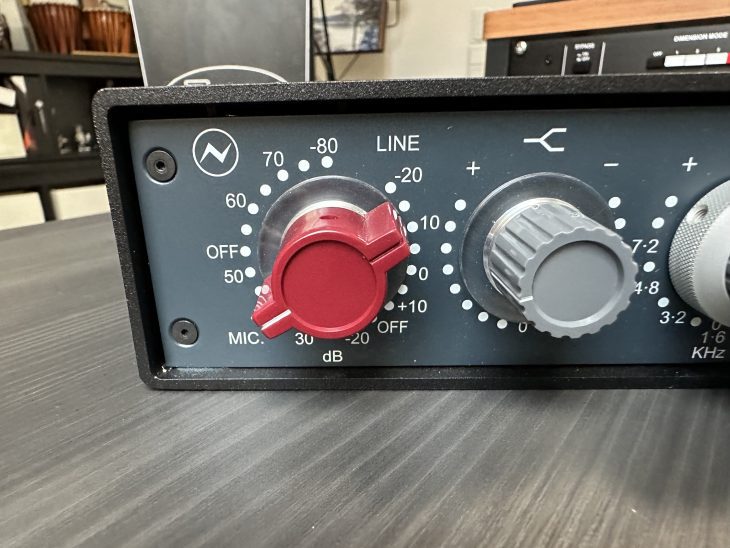
The input impedance of the microphone input can be switched between 300 ohms and 1,200 ohms on the back. Line is terminated with 10 kOhm and the DI input has either 1 MOhm (PAD off) or 10 kOhm (PAD on).
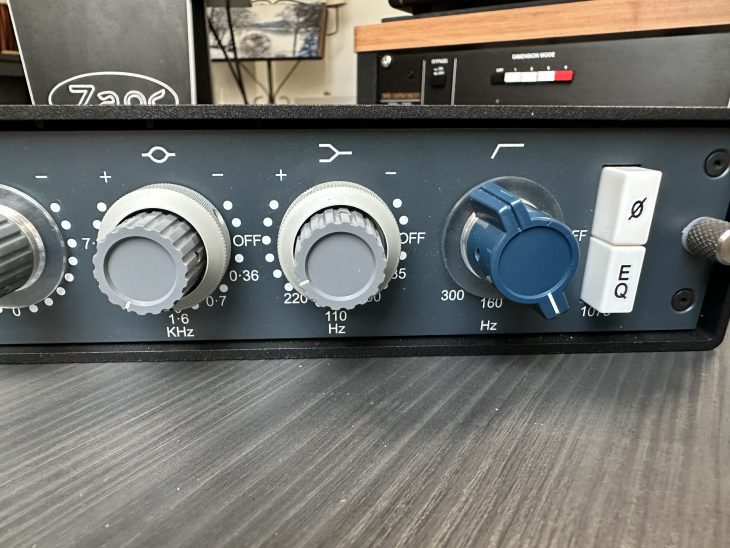
The equalizer is activated via a switch on the front and has three bands: The high shelf works from 12 kHz and can be adjusted in the range of ±16 dB. The mids cover the range from 360 Hz to 7.2 kHz in five steps and allow an adjustment of ±18 dB. The low-frequency range is also a shelving filter and allows ±16 dB adjustment for the frequencies 35 Hz, 60 Hz, 110 Hz and 220 Hz.
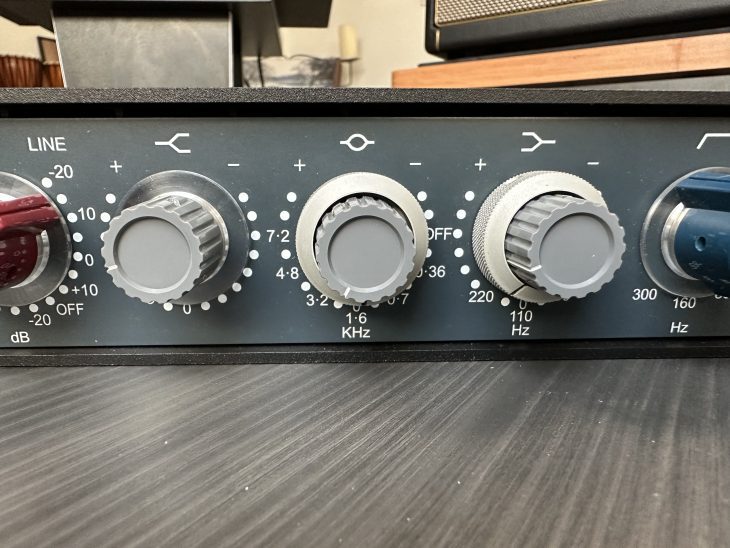
Finally, we have a high-pass filter to roll off the low frequencies at 18dB/oct. and switchable frequencies of 50, 80, 160 and 300 Hz.
For the mids and basses, the frequency is set with the outer ring and the ribbed rotary control takes over the level.
Finally, the phase can be rotated by 180 degrees using a switch on the front.

Admittedly, the back is a bit fiddly to use – this is a tribute to the fact that the device was originally designed to be built into the console. The input and output in XLR format (and a 6.3 mm jack socket for DI input) are easily accessible and the blue Amphenol connector, which is not required in the standalone version, is enthroned in the center. At least we have a dedicated on/off switch and underneath it is the socket for the external power supply.
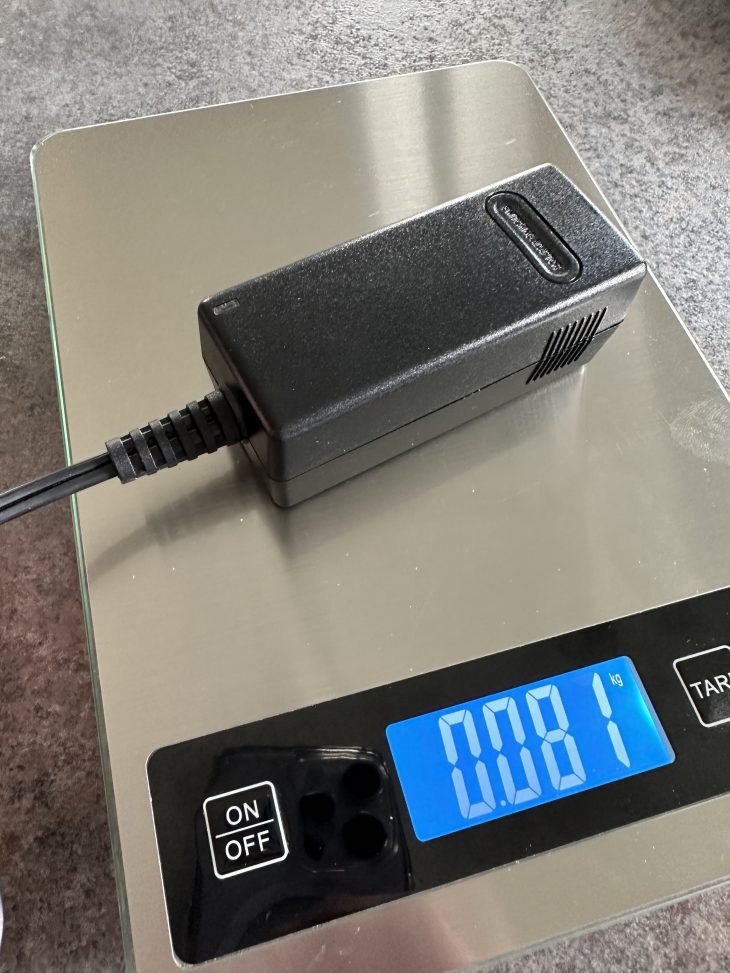
Here, AMS Neve seems to have looked in the box of the oldest and cheapest external power supplies and then included them with a 2,059 euro expensive noble preamp. I can only judge this by the weight (81 g!) and the external impression and maybe the cheap plastic housing of the power supply contains the finest components, but for the price I expect a clearly high-quality feel.

As mentioned, the rest of the switches are a bit fiddly and even on a standalone unit it would be nice if some of them could be found on the front panel. The termination with 5.1 kOhm is rarely needed and the ground lift switch can also stay at the back because of me.
But PAD with a 20 dB reduction, the HI-Z switch and in particular the activation of phantom power already belong on the front.
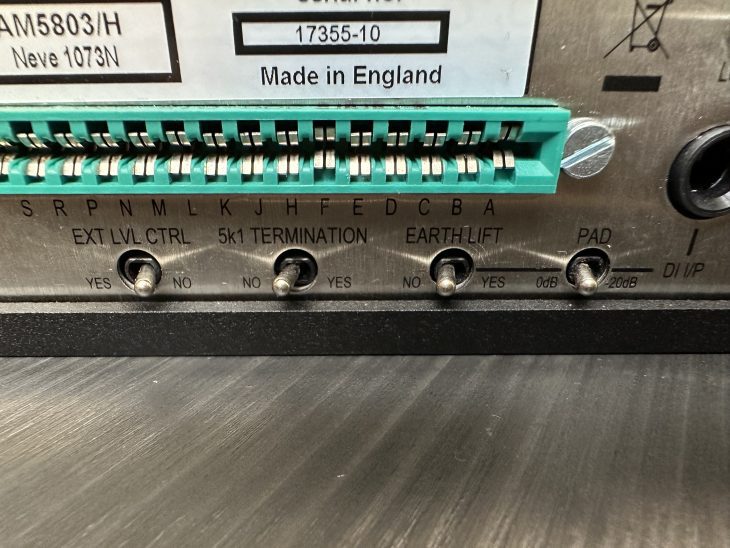
Especially since the latter indicates the operating status with a red LED, but can only be operated with a fingernail.
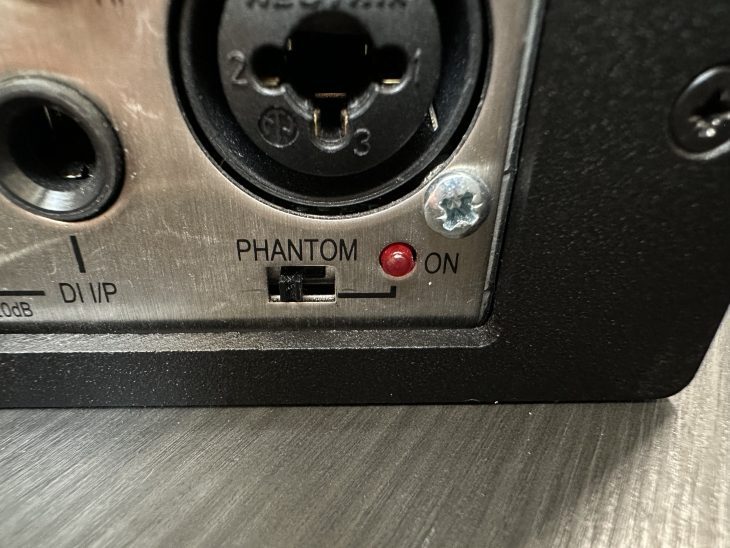
I know it would somehow be blasphemous to equip the classic 1073 front with more functions, but even a 1073 must and can measure itself against its competitors and cheaper replicas, and they have consistently brought the important functions of everyday studio life to the fore. Here I like to refer to the market overview of the 1073 preamp replicas and clones from my colleague Felix Thoma.
Technical data and practical use
Technically, the Neve 1073 looks good – there is no point where the device somehow weakens. The frequency range from 20 Hz to 20 kHz at ±0.5 dB and up to 40 kHz at -3 dB is very good and the signal-to-noise ratio is given as at least -83 dBU. Overall we are talking about -125 dB dynamics at 60 dB gain. In terms of distortion, it gets less than 0.07% in the 50Hz to 10kHz range at 20dBU at the output.

Noise or distortions are also not a problem in practice: the AMS Neve 1073N behaves very pleasantly here. The relatively large gain steps of 5 dB each are rather annoying for me. Since the 1073N does not have an output/trim control as a standalone unit, finding the optimum level is often a game of patience.
In my setting I connected the 1073 to my UAD Apollo X6 and when I recorded a Les Paul on a VOX AC15C1, as in my sound example, then the level adjustment is a tedious game with input levels from the SM57 microphone, the amplifier and the Apollo. In practice, 5 dB likes to make the difference between running hot and being overdriven. A decibel-accurate gain adjustment would bring more convenience and practicality here.
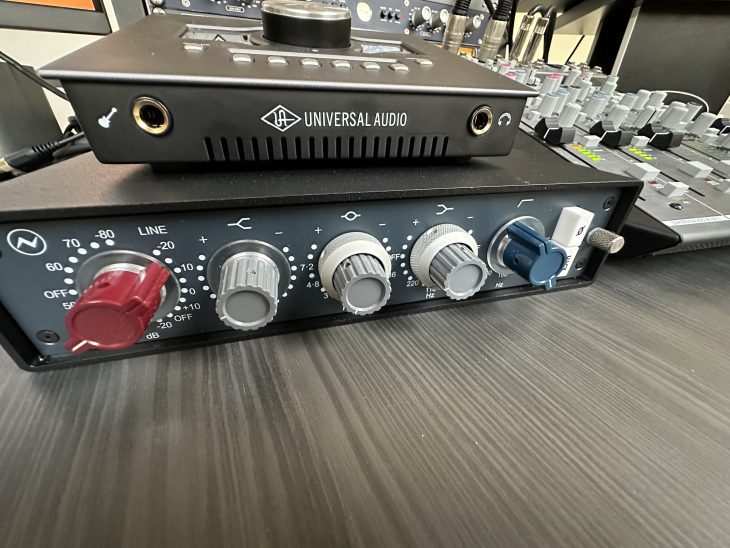
But – this comment is allowed – a legend like the AMS Neve 1073N can also allow itself a few quirks and demand more attention from the user. This is not a device to record something “quickly”, but to get the best possible sound quality for the triumvirate of interpreter, microphone and preamp. And that can also take time.
How does the AMS Neve 1073N preamp sound?
Music is emotions – this also applies to the production process. And there is definitely a difference if the sound comes from a “like” device or directly from the original. Many of us let this feeling cost a lot. A clone remains a clone and a replica is just a copy. This is not about blindly reproducible differences – please do not misunderstand. In the end, a recording of one can (and will) be Heritage Audio indistinguishable from a recording from an original AMS Neve 1073N. That’s why it’s important to change the perspective here:
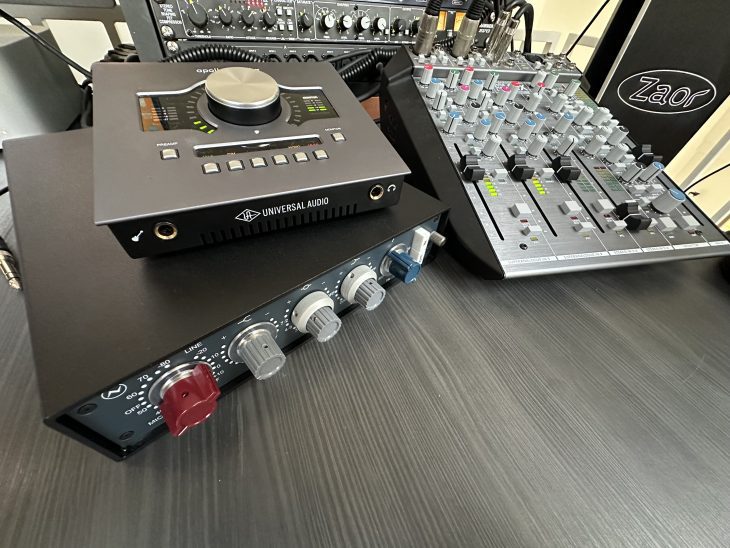
The “Who’s Who” in the studio: Neve, SSL and Universal Audio
Imagine you have a studio that you rent out to artists and producers. I can promise you: Even today, it is extremely attractive when the names in the rack cabinet TeletronixNeve and SSL can be found and NOT warm audio and Golden Age Audio.
When the man on the mixer sends the microphone through a real Neve, it does something to him: he feels safe using a professional tool and that also increases the demand on him to get a clean recording. We are also talking about corresponding productions with well-known artists and sound engineers. The very characteristic sound of an original Neve 1073, which has already been praised umpteen times, is a universe of its own every time. Warm, punchy and detailed without sounding too bright: That’s what I want when I choose the 1073 and that’s exactly what I get with this device.
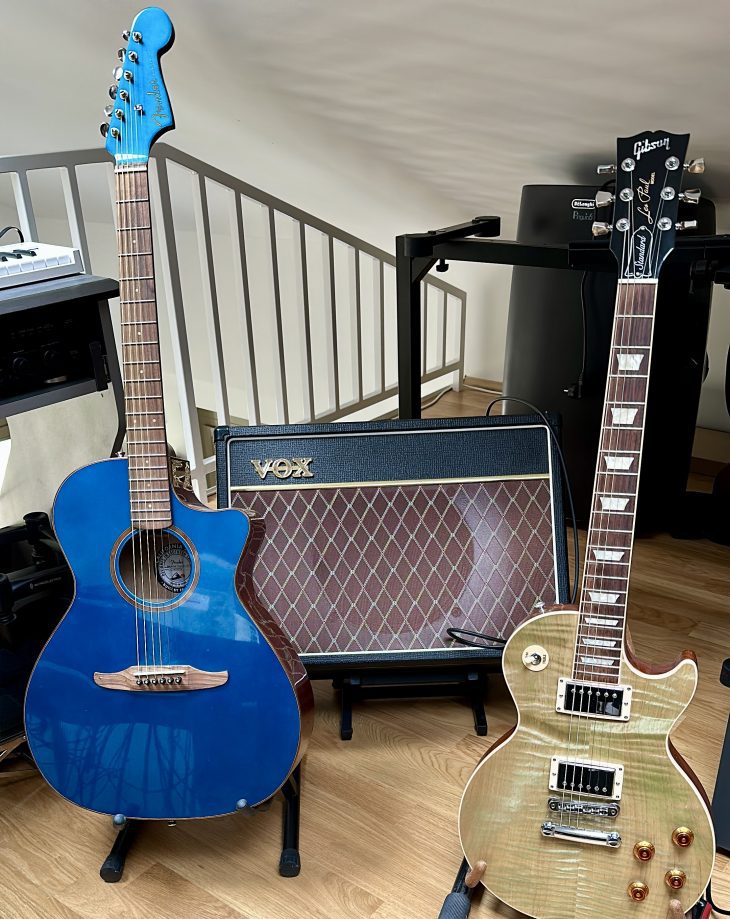
As mentioned above, I play a few chords on my Les Paul Standard on a VOX AC15 C1taken from a simple Shure SM57 at the edge of the 12″ chassis. The signal was not further processed and only the internal reverb of the VOX can be heard. If you carefully corrected this with an equalizer and brought a nice compressor into play … enough of the dreams! The AMS Neve 1073N sounds fantastic, authentic and original – because it is!
closing remark
If you say I can do this just as well with DAW’s own free plug-ins or you wouldn’t hear the difference from a replica or clone, then please note that you are NOT the target audience for this device. There are many very good devices and even plug-ins that replicate the sound of the 1073 almost perfectly. The AMS Neve 1073N is about having the original. And then you also pay 2,059 euros for a rather mediocre equipped 1-channel microphone preamp with somewhat quirky operation. Only the external power pack: I take that badly. Cheap and without connector lock. I don’t wish for more.

